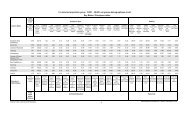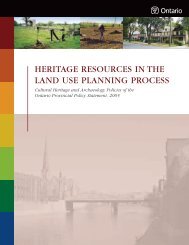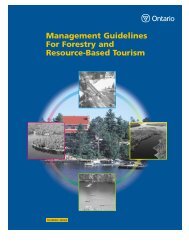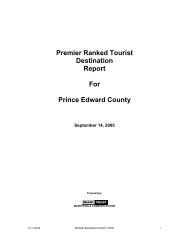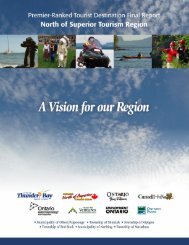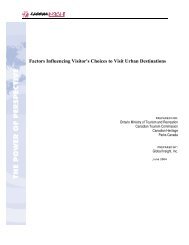Forest Operations on Crown Land - Ministry of Tourism
Forest Operations on Crown Land - Ministry of Tourism
Forest Operations on Crown Land - Ministry of Tourism
- No tags were found...
You also want an ePaper? Increase the reach of your titles
YUMPU automatically turns print PDFs into web optimized ePapers that Google loves.
FORESTRY OPERATIONS ON CROWN LANDA TECHNICAL BULLETIN FOR CONSULTANT ARCHAEOLOGISTS IN ONTARIO2011
FOREST OPERATIONSON CROWN LANDA Technical Bulletin for C<strong>on</strong>sultant Archaeologists in Ontario2011<strong>Ministry</strong> <strong>of</strong> <strong>Tourism</strong> and Culture
© Queen’s Printer for Ontario, 2011ISBN 978‐1‐4435‐6879‐1 (Print)ISBN 978‐1‐4435‐6880‐7 (HTML)ISBN 978‐1‐4435‐6881‐4 (PDF)
C<strong>on</strong>tentsOverview ...................................................................................................................................1Archaeological Assessments for <str<strong>on</strong>g>Forest</str<strong>on</strong>g> <str<strong>on</strong>g>Operati<strong>on</strong>s</str<strong>on</strong>g> <strong>on</strong> <strong>Crown</strong> <strong>Land</strong>s ...................................21 Pre-Stage 1: Determinati<strong>on</strong> <strong>of</strong> areas to be assessed by the c<strong>on</strong>sultant archaeologist 22 Stage 1: Background study and opti<strong>on</strong>al property inspecti<strong>on</strong> .....................................33 Stage 1 Assessments for <str<strong>on</strong>g>Forest</str<strong>on</strong>g> <str<strong>on</strong>g>Operati<strong>on</strong>s</str<strong>on</strong>g> <strong>on</strong> the Canadian Shield and in RemoteAreas ..............................................................................................................................43.1 Canadian Shield ....................................................................................................43.2 Remote areas ........................................................................................................54 Stage 2: Property survey................................................................................................55 Mitigating impacts to archaeological sites ....................................................................96 Avoidance <strong>of</strong> archaeological sites during forest operati<strong>on</strong>s ......................................107 Engaging Aboriginal communities in archaeology.....................................................108 Reporting .....................................................................................................................119 Other aspects <strong>of</strong> the forest management planning process ..................................1110 Glossary.......................................................................................................................13
OverviewThis bulletin is intended to help c<strong>on</strong>sultant archaeologists as they follow the Standards andGuidelines for C<strong>on</strong>sultant Archaeologists (2011) to carry out archaeological assessments forforest management plans and mitigate impacts to archaeological sites during forestmanagement activities <strong>on</strong> <strong>Crown</strong> land.<str<strong>on</strong>g>Forest</str<strong>on</strong>g> resource licence holders are required to address a range <strong>of</strong> possible heritage impactswhen c<strong>on</strong>ducting forestry operati<strong>on</strong>s. This includes ensuring that the Ontario Heritage Act isfollowed so that registered archaeological sites are protected and the disturbance <strong>of</strong>unidentified archaeological sites as a result <strong>of</strong> forest operati<strong>on</strong>s is minimized.The Ontario Heritage Act sets out priorities, policies, and programs for the c<strong>on</strong>servati<strong>on</strong> <strong>of</strong>archaeological resources <strong>of</strong> cultural heritage value. It also provides for the licensing <strong>of</strong>individuals who wish to carry out archaeological fieldwork. The <strong>Ministry</strong> <strong>of</strong> <strong>Tourism</strong> andCulture’s Standards and Guidelines for C<strong>on</strong>sultant Archaeologists (2011) defines the practicesc<strong>on</strong>sultant archaeologists must follow when employed by a prop<strong>on</strong>ent to address thearchaeological c<strong>on</strong>servati<strong>on</strong> requirements set out in the Ontario Heritage Act.The Standards and Guidelines recognize certain unique features <strong>of</strong> archaeologicalassessments carried out in c<strong>on</strong>necti<strong>on</strong> with forest operati<strong>on</strong>s <strong>on</strong> <strong>Crown</strong> <strong>Land</strong>s. Thisbulletin expands <strong>on</strong> the Standards and Guidelines by outlining a process specific to forestoperati<strong>on</strong>s <strong>on</strong> <strong>Crown</strong> land that allows for the identificati<strong>on</strong> and subsequent avoidance andprotecti<strong>on</strong> <strong>of</strong> areas <strong>of</strong> archaeological potential and known archaeological sites withinforest management units <strong>on</strong> <strong>Crown</strong> land.As an additi<strong>on</strong>al source <strong>of</strong> informati<strong>on</strong>, the <strong>Ministry</strong> <strong>of</strong> <strong>Tourism</strong> and Culture’s draftbulletin Engaging Aboriginal Communities in Archaeology may be helpful to c<strong>on</strong>sultantarchaeologists working in forestry c<strong>on</strong>texts as it clarifies best practices for engagingAboriginal communities in the archaeological assessment process.Archaeological Assessments for <str<strong>on</strong>g>Forest</str<strong>on</strong>g> <str<strong>on</strong>g>Operati<strong>on</strong>s</str<strong>on</strong>g> <strong>on</strong> <strong>Crown</strong> <strong>Land</strong>s | 1
Archaeological Assessments for <str<strong>on</strong>g>Forest</str<strong>on</strong>g> <str<strong>on</strong>g>Operati<strong>on</strong>s</str<strong>on</strong>g> <strong>on</strong><strong>Crown</strong> <strong>Land</strong>s1 Pre-Stage 1: Determinati<strong>on</strong> <strong>of</strong> areas to be assessed by the c<strong>on</strong>sultantarchaeologistThe objective <strong>of</strong> a Stage 1 archaeological assessment is to determine whether there ispotential for archaeological sites to be present <strong>on</strong> a property. The findings <strong>of</strong> the Stage 1assessment will support recommendati<strong>on</strong>s about the required extent and locati<strong>on</strong> <strong>of</strong> Stage2 survey.In general, Stage 1 involves a background study where the c<strong>on</strong>sultant archaeologists willreview geographic, land use, and historical informati<strong>on</strong> for the property and the relevantsurrounding area. They will also c<strong>on</strong>tact the <strong>Ministry</strong> <strong>of</strong> <strong>Tourism</strong> and Culture to find outwhether or not there are any known archaeological sites present <strong>on</strong> or near the property.The c<strong>on</strong>sultant archaeologist has the opti<strong>on</strong> <strong>of</strong> also visiting the property in order toinspect its current c<strong>on</strong>diti<strong>on</strong>. One result <strong>of</strong> a Stage 1 assessment is a map identifying areas<strong>of</strong> archaeological potential recommended for Stage 2 survey.For forest operati<strong>on</strong>s <strong>on</strong> <strong>Crown</strong> land, the <strong>Ministry</strong> <strong>of</strong> Natural Resources uses its ownscreening process to define the areas that will require Stage 2 archaeological assessmentwithin a forest management unit licensed for harvest. This process is described in Secti<strong>on</strong>1.4.3 <strong>of</strong> the Standards and Guidelines.From the Standards and Guidelines for C<strong>on</strong>sultant Archaeologists (2011) (Secti<strong>on</strong> 1.4.3):The following process applies to all forestry projects <strong>on</strong> <strong>Crown</strong> land where the <strong>Ministry</strong> <strong>of</strong> NaturalResources uses its screening process to define the areas that will require archaeological assessmentwithin a forest management unit. The screening process includes the following steps:Step 1Mapping <strong>of</strong> archaeological potential, based <strong>on</strong> a model <strong>of</strong> potential that gives weight and value tospecific landscape elements, including: reviewing the locati<strong>on</strong>s <strong>of</strong> registered archaeological sites and other sites with cultural heritagevalue. <strong>Land</strong>form types that have str<strong>on</strong>ger associati<strong>on</strong>s with such sites are assigned highervalues. c<strong>on</strong>firmati<strong>on</strong> by the <strong>Ministry</strong> <strong>of</strong> Natural Resources <strong>of</strong> this preliminary model <strong>of</strong> archaeologicalpotential by reviewing additi<strong>on</strong>al informati<strong>on</strong> available internally and from the localcommunity, aerial photography, and historical mappingAreas determined by this mapping to be lacking archaeological potential are at this point exemptedfrom Stage 2 survey.Step 2The prop<strong>on</strong>ent and the <strong>Ministry</strong> <strong>of</strong> Natural Resources use that ministry’s <str<strong>on</strong>g>Forest</str<strong>on</strong>g> Management Guide forCultural Heritage Values (2007) to evaluate the activities planned for the forestry project for theirArchaeological Assessments for <str<strong>on</strong>g>Forest</str<strong>on</strong>g> <str<strong>on</strong>g>Operati<strong>on</strong>s</str<strong>on</strong>g> <strong>on</strong> <strong>Crown</strong> <strong>Land</strong>s | 2
potential to alter the ground to the point <strong>of</strong> having an impact <strong>on</strong> any potential archaeological sites inthose areas determined to have potential. Where there are planned impacts, they review bestpractices for avoiding those alterati<strong>on</strong>s or reducing their impact (e.g., changing the locati<strong>on</strong> <strong>of</strong> a watercrossing, restricting activities to frozen ground c<strong>on</strong>diti<strong>on</strong>s).Step 3Stage 2 survey is <strong>on</strong>ly required where impacts to areas with archaeological potential cannot beavoided. Note that the alternative strategy for Stage 2 test pitting in northern Ontario and theCanadian Shield outlined in secti<strong>on</strong> 2.1.5 will usually apply to forestry projects.As a result <strong>of</strong> this screening process, the <strong>Ministry</strong> <strong>of</strong> Natural Resources will provide theforest resource licence holder with a map outlining the areas <strong>of</strong> archaeological potentialwithin the forest management unit that will require Stage 2 archaeological assessment. Thelicence holder then determines what harvest operati<strong>on</strong>s, if any, will occur in these areas, inc<strong>on</strong>sultati<strong>on</strong> with the <strong>Ministry</strong> <strong>of</strong> Natural Resources. This process is discussed in the<strong>Ministry</strong> <strong>of</strong> Natural Resource’s <str<strong>on</strong>g>Forest</str<strong>on</strong>g> Management Guide for Cultural Heritage Values (2007).The c<strong>on</strong>sultant archaeologist will likely NOT be involved in the determinati<strong>on</strong> process.If areas <strong>of</strong> proposed ground disturbance and areas <strong>of</strong> archaeological potential do notoverlap, then no archaeological assessment is required. For areas where archaeologicalpotential has been identified, there are three harvest opti<strong>on</strong>s available to the forestresource licence holder:1. No harvest2. Harvest with less than 5% mineral soil disturbance3. Harvest with greater than 5% mineral soil disturbanceThe last opti<strong>on</strong> (Opti<strong>on</strong> 3) requires a Stage 2 archaeological assessment by a c<strong>on</strong>sultantarchaeologist prior to any soil disturbance.2 Stage 1: Background study and opti<strong>on</strong>al property inspecti<strong>on</strong>Secti<strong>on</strong> 1.4.3 <strong>of</strong> the Standards and Guidelines outlines criteria that c<strong>on</strong>sultantarchaeologists may use to further refine the areas requiring Stage 2 archaeologicalassessment as determined by the <strong>Ministry</strong> <strong>of</strong> Natural Resources’ screening process.From the Standards and Guidelines for C<strong>on</strong>sultant Archaeologists (2011) (Secti<strong>on</strong> 1.4.3):GuidelinesIn instances where it is suspected that an <strong>on</strong>‐the‐ground inspecti<strong>on</strong> may quickly determine that thereis no archaeological potential despite the results <strong>of</strong> the potential mapping, it may be useful toc<strong>on</strong>duct a Stage 1 property inspecti<strong>on</strong>. For most forest operati<strong>on</strong>s projects, however, it may be morepractical and efficient to combine <strong>on</strong>‐the‐ground evaluati<strong>on</strong>s <strong>of</strong> archaeological potential with theStage 2 fieldwork.Archaeological Assessments for <str<strong>on</strong>g>Forest</str<strong>on</strong>g> <str<strong>on</strong>g>Operati<strong>on</strong>s</str<strong>on</strong>g> <strong>on</strong> <strong>Crown</strong> <strong>Land</strong>s | 3
There are a number <strong>of</strong> activities a c<strong>on</strong>sultant archaeologist may undertake to further refinethe areas <strong>of</strong> c<strong>on</strong>firmed archaeological potential identified during the <strong>Ministry</strong> <strong>of</strong> NaturalResources’ screening process before visiting the forest management area to carry out aStage 1 property inspecti<strong>on</strong> or Stage 2 assessment. For example: review aerial photographs,topographic maps or forest resource inventory maps; or view the areas from a helicopter.This Stage 1 research results in a map for planned Stage 2 activities. For most assessmentscarried out in c<strong>on</strong>necti<strong>on</strong> to forestry operati<strong>on</strong>s, it is practical and efficient to combine aStage 1 property inspecti<strong>on</strong> with Stage 2 fieldwork.3 Stage 1 Assessments for <str<strong>on</strong>g>Forest</str<strong>on</strong>g> <str<strong>on</strong>g>Operati<strong>on</strong>s</str<strong>on</strong>g> <strong>on</strong> the Canadian Shieldand in Remote AreasManagement plans for forest operati<strong>on</strong>s <strong>on</strong> <strong>Crown</strong> land will <strong>of</strong>ten involve archaeologicalassessment <strong>of</strong> properties <strong>on</strong> the Canadian Shield or in remote areas. As a result, c<strong>on</strong>sultantarchaeologists will <strong>of</strong>ten be able to use the alternative strategies for the evaluati<strong>on</strong> <strong>of</strong>archaeological potential <strong>on</strong> these kinds <strong>of</strong> properties set out in the Standards andGuidelines and reproduced here in Secti<strong>on</strong>s 3.1 and 3.2.3.1 Canadian ShieldFor the purposes <strong>of</strong> the Standards and Guidelines, the Canadian Shield is defined as thearea <strong>of</strong> Ontario underlain by the Precambrian Shield. If a property to be harvested islocated <strong>on</strong> the Shield, it may be determined that the area requiring Stage 2 survey can bereduced and that some areas requiring Stage 2 survey may be recommended for alternativeStage 2 survey according to the following standards:From the Standards and Guidelines for C<strong>on</strong>sultant Archaeologists (2011) (Secti<strong>on</strong> 1.3.3):Standards1. The lands to be assessed must be dem<strong>on</strong>strated to be located <strong>on</strong> the Canadian Shield.2. There may be small pockets (e.g., sand plains, clay plains, glacial beach ridges, etc.) that possess ahigher degree <strong>of</strong> potential and differing characteristics from most <strong>of</strong> the surrounding envir<strong>on</strong>mentthat should still be c<strong>on</strong>sidered to have potential. Where such areas <strong>of</strong> higher potential areidentified, undertake a complete assessment and systematic surveys.See Secti<strong>on</strong> 4 for a discussi<strong>on</strong> <strong>of</strong> alternative Stage 2 strategies.Archaeological Assessments for <str<strong>on</strong>g>Forest</str<strong>on</strong>g> <str<strong>on</strong>g>Operati<strong>on</strong>s</str<strong>on</strong>g> <strong>on</strong> <strong>Crown</strong> <strong>Land</strong>s | 4
3.2 Remote areasIf Stage 1 evaluati<strong>on</strong>s <strong>of</strong> archaeological potential are being made for areas that are remoteand difficult to access and a property inspecti<strong>on</strong> is not viable, it is acceptable to makerecommendati<strong>on</strong>s that remote areas are <strong>of</strong> low potential and will not require Stage 2assessment under the following c<strong>on</strong>diti<strong>on</strong>s:From the Standards and Guidelines for C<strong>on</strong>sultant Archaeologists (2011) (Secti<strong>on</strong> 1.3.4):Standards1. The degree <strong>of</strong> remoteness must be documented in sufficient detail to dem<strong>on</strong>strate that there arepractical obstacles to achieving access. This will be primarily a matter <strong>of</strong> distance and a lack <strong>of</strong>available transportati<strong>on</strong> infrastructure (i.e., roads, trails) al<strong>on</strong>g with factors <strong>of</strong> visibility (e.g., forestcover). Factors relating to seas<strong>on</strong>ality (e.g. snow cover, flooding) should not be a factor indem<strong>on</strong>strating difficulties <strong>of</strong> access.2. Aerial photos, detailed engineering plans or other detailed mapped informati<strong>on</strong> may be used todetermine that areas are <strong>of</strong> low potential. This informati<strong>on</strong> must be at a scale and <strong>of</strong> a sufficientlydetailed quality that allows for accurate evaluati<strong>on</strong> <strong>of</strong> the presence and character <strong>of</strong> features <strong>of</strong>potential. The characteristics and quality <strong>of</strong> the sources <strong>of</strong> informati<strong>on</strong> (e.g., scale, source, howrecently the informati<strong>on</strong> was acquired, general reliability) must be documented in sufficient detail todem<strong>on</strong>strate its ability to support accurate evaluati<strong>on</strong>s <strong>of</strong> potential.4 Stage 2: Property surveyWhile the Standards and Guidelines set out requirements for Stage 2 assessments forforest operati<strong>on</strong>s, there is a str<strong>on</strong>g element <strong>of</strong> pr<strong>of</strong>essi<strong>on</strong>al judgment <strong>on</strong> the part <strong>of</strong> thec<strong>on</strong>sultant archaeologist in implementing those requirements. During a Stage 2 propertysurvey, the c<strong>on</strong>sultant archaeologist verifies the accuracy <strong>of</strong> the archaeological potentialmap produced at the end <strong>of</strong> the <strong>Ministry</strong> <strong>of</strong> Natural Resources screening process and Stage1 assessment and carries out Stage 2 survey <strong>of</strong> those areas identified as havingarchaeological potential. Only areas identified as having archaeological potential requiresurvey.The archaeological potential map produced at the end <strong>of</strong> the screening process and Stage 1assessment may be further refined by the archaeologist up<strong>on</strong> viewing the property duringthe Stage 2 survey through field identificati<strong>on</strong> <strong>of</strong> additi<strong>on</strong>al areas with no archaeologicalpotential. Secti<strong>on</strong> 2.1 <strong>of</strong> the Standards and Guidelines sets out criteria that the c<strong>on</strong>sultantarchaeologist can follow to identify areas that do not require Stage 2 survey. Thesedeterminati<strong>on</strong>s can <strong>on</strong>ly be made by the c<strong>on</strong>sultant archaeologist <strong>on</strong> the ground and based<strong>on</strong> their experience, pr<strong>of</strong>essi<strong>on</strong>al judgment, and the geography <strong>of</strong> the area. Areas such asthose that are permanently wet, steeply sloped or bare rock are exempted from survey.Archaeological Assessments for <str<strong>on</strong>g>Forest</str<strong>on</strong>g> <str<strong>on</strong>g>Operati<strong>on</strong>s</str<strong>on</strong>g> <strong>on</strong> <strong>Crown</strong> <strong>Land</strong>s | 5
From the Standards and Guidelines for C<strong>on</strong>sultant Archaeologists (2011) (Secti<strong>on</strong> 2.1):Standards1. Survey the entire property, including landsimmediately adjacent to built structures (both intactand ruins).2. Survey is not required where:a. lands are evaluated as having no or lowpotential based <strong>on</strong> the Stage 2 identificati<strong>on</strong> <strong>of</strong>physical features <strong>of</strong> no or low archaeologicalpotential, including but not limited to:i. permanently wet areasii.exposed bedrockiii. steep slopes (greater than 20) except inlocati<strong>on</strong>s likely to c<strong>on</strong>tain pictographs orpetroglyphsb. lands are evaluated as having no or lowpotential based <strong>on</strong> the Stage 2 identificati<strong>on</strong> <strong>of</strong>extensive and deep land alterati<strong>on</strong> that hasseverely damaged the integrity <strong>of</strong> archaeologicalresourcesc. lands have been recommended to not requireStage 2 assessment by a Stage 1 report, wherethe ministry has accepted the Stage 1 reportinto the report registerd. lands are designated for forest managementactivity without potential for impacts toarchaeological sites, as determined through theStage 1 forest management plans process (seesecti<strong>on</strong> 1.4.3)e. lands are formally prohibited from alterati<strong>on</strong>such as areas in an envir<strong>on</strong>mental easement,restrictive setback, or prohibitive z<strong>on</strong>ing, wherethe c<strong>on</strong>straint prohibits any form <strong>of</strong> soildisturbance. (Open space and otherdesignati<strong>on</strong>s where allowable uses include landalterati<strong>on</strong>s must be surveyed.)f. it has been c<strong>on</strong>firmed that the lands are beingtransferred to a public land‐holding body, e.g.,municipality, c<strong>on</strong>servati<strong>on</strong> authority, provincialagency. (This does not apply to lands for which afuture transfer is c<strong>on</strong>templated but not yetc<strong>on</strong>firmed.)Guidelines1. When permanent fixed referencelandmarks (e.g., Ontario <strong>Land</strong> Surveyorbenchmarks, solid ir<strong>on</strong> bars) are present,it is acceptable to record the locati<strong>on</strong>srequired by Standard 4 <strong>of</strong> this secti<strong>on</strong>using methods such as total stati<strong>on</strong>,transit and tape, or stadia rod. Theminimum GPS readings required insecti<strong>on</strong> 5 must still be taken.2. Remote sensing may be used tosupplement other methods <strong>of</strong> propertysurvey, but not as an alternative.3. If areas are exempt from survey becausethe lands are formally prohibited fromalterati<strong>on</strong> (Standard 2.e) or are beingtransferred to a public land‐holding body(Standard 2.f), but those lands areevaluated as having no or low potentialbased <strong>on</strong> the Stage 2 identificati<strong>on</strong> <strong>of</strong>physical features <strong>of</strong> no or lowarchaeological potential (Standard 2.a) or<strong>of</strong> extensive or deep land alterati<strong>on</strong>(Standard 2.b), documentati<strong>on</strong> <strong>of</strong> theno/low potential evaluati<strong>on</strong> may besubmitted in place <strong>of</strong> documentati<strong>on</strong>related to the exempti<strong>on</strong> criteria.Archaeological Assessments for <str<strong>on</strong>g>Forest</str<strong>on</strong>g> <str<strong>on</strong>g>Operati<strong>on</strong>s</str<strong>on</strong>g> <strong>on</strong> <strong>Crown</strong> <strong>Land</strong>s | 6
Stage 2 assessment in the forestry c<strong>on</strong>text will usually involve test pit survey. TheStandards and Guidelines outline acceptable test pitting methods and strategies. However,forest operati<strong>on</strong>s <strong>of</strong>ten involve c<strong>on</strong>diti<strong>on</strong>s that are different than those <strong>of</strong> other types <strong>of</strong>projects. Under the three special circumstances set out below, the c<strong>on</strong>sultant archaeologistmay make use <strong>of</strong> alternative strategies designed to address these differences in c<strong>on</strong>diti<strong>on</strong>s:1. Secti<strong>on</strong> 2.1.5 <strong>of</strong> the Standards and Guidelines sets out an alternative strategy for testpit survey in northern Ontario and <strong>on</strong> Canadian Shield terrain. This strategy recognizesthat <strong>on</strong> the Canadian Shield the areas <strong>of</strong> high potential for archaeological sites aremore restricted than they are in more southerly parts <strong>of</strong> Ontario. As such, the areasaround features <strong>of</strong> archaeological potential that require test pitting are reduced and theassociated requirements for test pitting intervals are also reduced.For Standard 1 below, a joint study by the <strong>Ministry</strong> <strong>of</strong> <strong>Tourism</strong> and Culture and the<strong>Ministry</strong> <strong>of</strong> Natural Resources analysed a large sample <strong>of</strong> archaeological sitesdistributed across a wide variety <strong>of</strong> different regi<strong>on</strong>s throughout northern Ontario.That study determined that a high percentage <strong>of</strong> the sites would have been identifiedby survey within 50 metres <strong>of</strong> a modern water source.For Standard 2, maps <strong>of</strong> other features indicating archaeological potential are <strong>of</strong>tennot as readily available or as comprehensive as those <strong>of</strong> modern water sources.<strong>Ministry</strong> c<strong>on</strong>sultati<strong>on</strong> with archaeologists raised c<strong>on</strong>cern that archaeological sitesrelated to other features <strong>of</strong> potential may not be discovered because <strong>of</strong> the greaterdifficulty <strong>of</strong> identifying those features (e.g., glacial shorelines) during Stage 1background research.As a result <strong>of</strong> this c<strong>on</strong>sultati<strong>on</strong>, a more c<strong>on</strong>servative standard was established. In linewith that c<strong>on</strong>servative approach, c<strong>on</strong>sultant archaeologists must meet this standardwhere any feature <strong>of</strong> potential other than a modern water source is identified. In otherwords, Standard 2 will prevail over Standard 1 where both classes <strong>of</strong> features overlap.From the Standards and Guidelines for C<strong>on</strong>sultant Archaeologists (2011) (Secti<strong>on</strong> 2.1.5):Test pit survey in northern Ontario and <strong>on</strong> Canadian Shield terrainStandards1. Where the identified feature <strong>of</strong>archaeological potential is a modern watersource, test pitting is required between 0and 50 m from the feature. Space test pits atmaximum intervals <strong>of</strong> 5 m. Survey is notrequired bey<strong>on</strong>d 50 m.2. For features <strong>of</strong> archaeological potentialother than modern water sources (e.g.,historic water sources such as glacialGuidelines1. Clustered test pits may be used to surveysmall areas <strong>of</strong> archaeological potentiallocated in areas otherwise determined to be<strong>of</strong> low archaeological potential.Archaeological Assessments for <str<strong>on</strong>g>Forest</str<strong>on</strong>g> <str<strong>on</strong>g>Operati<strong>on</strong>s</str<strong>on</strong>g> <strong>on</strong> <strong>Crown</strong> <strong>Land</strong>s | 7
shorelines), test pitting is required asfollows:a. space test pits at maximum intervals <strong>of</strong>5 m between 0 and 50 m from thefeature <strong>of</strong> archaeological potentialb. space test pits at maximum intervals <strong>of</strong>10 m between 50 and 150 m from thefeature <strong>of</strong> archaeological potentialc. survey is not required bey<strong>on</strong>d 150 m3. While maintaining standard survey grids asclosely as possible, the c<strong>on</strong>sultantarchaeologist may vary from standardsurvey grids as necessary, based <strong>on</strong>pr<strong>of</strong>essi<strong>on</strong>al judgment. Document andexplain the rati<strong>on</strong>ale for all variati<strong>on</strong>s in theStage 2 report.2. The alternative strategy for test pit survey in areas with complex combinati<strong>on</strong>s <strong>of</strong>archaeological potential recognizes that, in the course <strong>of</strong> surveying areas previouslyidentified as having archaeological potential, the c<strong>on</strong>sultant archaeologist maydetermine that an area c<strong>on</strong>sists <strong>of</strong> a complex combinati<strong>on</strong> <strong>of</strong> land c<strong>on</strong>diti<strong>on</strong>s resultingin small areas <strong>of</strong> archaeological potential intermixed with areas <strong>of</strong> low potential.Examples include small pockets <strong>of</strong> soil scattered throughout a broader bare limest<strong>on</strong>eplain, or dry areas scattered throughout broader wetlands. These small areas <strong>of</strong>archaeological potential must be surveyed, but it may not be possible to maintain aregular test pit grid or provide a precise map <strong>of</strong> all the surveyed areas.From the Standards and Guidelines for C<strong>on</strong>sultant Archaeologists (2011) (Secti<strong>on</strong> 2.1.6):Test pit survey in areas with complex combinati<strong>on</strong>s <strong>of</strong> archaeological potentialStandards1. Survey all parts <strong>of</strong> these areas that are determined to have archaeological potential usingstandard test pit survey intervals. While maintaining standard survey grids as closely as possible, the c<strong>on</strong>sultant archaeologistmay vary from standard survey grids as necessary, based <strong>on</strong> pr<strong>of</strong>essi<strong>on</strong>al judgment.Document and explain the rati<strong>on</strong>ale for all variati<strong>on</strong>s in the Stage 2 report.2. Record surveyed areas and areas <strong>of</strong> low potential not surveyed to the greatest degree <strong>of</strong>precisi<strong>on</strong> possible given the available base mapping. Based <strong>on</strong> pr<strong>of</strong>essi<strong>on</strong>al judgment, the c<strong>on</strong>sultant archaeologist may map an area c<strong>on</strong>tainingcomplex combinati<strong>on</strong>s <strong>of</strong> c<strong>on</strong>diti<strong>on</strong>s as <strong>on</strong>e unit. Where this approach is followed, record thecharacteristics <strong>of</strong> the area through photographs and detailed written field notes (e.g.,percentages <strong>of</strong> different physical features and areas <strong>of</strong> potential, percentages surveyed andnot surveyed, degree <strong>of</strong> variati<strong>on</strong> within the area).Archaeological Assessments for <str<strong>on</strong>g>Forest</str<strong>on</strong>g> <str<strong>on</strong>g>Operati<strong>on</strong>s</str<strong>on</strong>g> <strong>on</strong> <strong>Crown</strong> <strong>Land</strong>s | 8
3. There is also an alternative strategy applicable to the special c<strong>on</strong>diti<strong>on</strong> <strong>of</strong> undisturbedforest floors with shallow soils (e.g., combined A and B horiz<strong>on</strong>s <strong>of</strong> less than 5 cm) setout in Secti<strong>on</strong> 2.1.9 <strong>of</strong> the Standards and Guidelines. This strategy has limitedapplicati<strong>on</strong> in forest operati<strong>on</strong> areas.Note that if n<strong>on</strong>e <strong>of</strong> the special c<strong>on</strong>diti<strong>on</strong>s listed above apply, the c<strong>on</strong>sultant archaeologistis required to follow the general standards and guidelines for test pit surveys set out insecti<strong>on</strong>s 2.1.2 and 2.1.3 <strong>of</strong> the Standards and Guidelines.Although the general and special c<strong>on</strong>diti<strong>on</strong> standards for Stage 2 provide minimumrequirements which the c<strong>on</strong>sultant archaeologist must satisfy, it is recognized that thesestandards may not address every situati<strong>on</strong>. It may be necessary in some instances to useother approaches to resp<strong>on</strong>d to unusual c<strong>on</strong>diti<strong>on</strong>s. However, all c<strong>on</strong>sultant archaeologistsmust discuss any approaches that depart from the Standards and Guidelines with <strong>Ministry</strong><strong>of</strong> <strong>Tourism</strong> and Culture staff before applying them in the field.Other approaches are likely to be acceptable to the ministry where they do not c<strong>on</strong>flictwith the standards and are c<strong>on</strong>sistent with the general goal <strong>of</strong> the c<strong>on</strong>servati<strong>on</strong> <strong>of</strong>archaeological sites. C<strong>on</strong>sultant archaeologists who depart from the Standards andGuidelines must clearly describe the rati<strong>on</strong>ale for the change in approach, the new strategyand any discussi<strong>on</strong>s with the <strong>Ministry</strong> <strong>of</strong> <strong>Tourism</strong> and Culture in the report that iseventually filed for the project (see Secti<strong>on</strong> 8 below). Secti<strong>on</strong> 2.10 <strong>of</strong> the bulletin ProjectInformati<strong>on</strong> Forms (PIFs) and the Archaeological Report Review Process provides guidance forlicensees who are c<strong>on</strong>sidering alternate fieldwork strategies to those allowable under theStandards and Guidelines.5 Mitigating impacts to archaeological sitesThe outcome <strong>of</strong> a Stage 2 test pit survey may be the identificati<strong>on</strong> <strong>of</strong> archaeological siteswithin an area <strong>of</strong> archaeological potential. When a site is discovered Secti<strong>on</strong> 2.1.3 <strong>of</strong> theStandards and Guidelines provides the opti<strong>on</strong> <strong>of</strong> undertaking additi<strong>on</strong>al Stage 2 test pittingin order to determine whether the archaeological site has cultural heritage value or interestbased <strong>on</strong> criteria set out in the Standards and Guidelines and the archaeologist'spr<strong>of</strong>essi<strong>on</strong>al judgment. The outcome <strong>of</strong> this additi<strong>on</strong>al testing is an understanding <strong>of</strong>whether Stage 3 testing <strong>of</strong> the site may be necessary.The acceptable strategies for mitigating impacts to archaeological sites identified duringStage 2 survey and that are <strong>of</strong> further c<strong>on</strong>cern are:Following a Stage 2 assessment, the forest resource licence holder may opt to protectthe site without the Stage 3 testing that would determine its cultural heritage value orinterest and spatial boundaries. If so, a c<strong>on</strong>servative approach to site protecti<strong>on</strong> isArchaeological Assessments for <str<strong>on</strong>g>Forest</str<strong>on</strong>g> <str<strong>on</strong>g>Operati<strong>on</strong>s</str<strong>on</strong>g> <strong>on</strong> <strong>Crown</strong> <strong>Land</strong>s | 9
necessary and a buffer z<strong>on</strong>e must be established with a radius <strong>of</strong> at least 200 metresfrom the estimated center <strong>of</strong> the site.Alternatively, a Stage 3 archaeological assessment may be undertaken to define thespatial boundaries <strong>of</strong> the site and determine its cultural heritage value or interest, afterwhich a buffer z<strong>on</strong>e <strong>of</strong> 10 metres from this boundary can be established. Stage 3assessment may also find that the site has been sufficiently documented and is <strong>of</strong> n<strong>of</strong>urther cultural heritage value or interest and will not require protecti<strong>on</strong>.Finally, a Stage 4 excavati<strong>on</strong> may be carried out to completely document and removethe site, allowing normal forestry operati<strong>on</strong>s to proceed.If the impacts to an archaeological site are not mitigated through complete excavati<strong>on</strong> <strong>of</strong>the site, the use <strong>of</strong> the buffer z<strong>on</strong>e will ensure the protecti<strong>on</strong> <strong>of</strong> the archaeological siteduring forest operati<strong>on</strong>s.6 Avoidance <strong>of</strong> archaeological sites during forest operati<strong>on</strong>s<str<strong>on</strong>g>Forest</str<strong>on</strong>g> resource licence holders will <strong>of</strong>ten opt not to harvest in areas where archaeologicalsites have been identified during Stage 2 archaeological assessment. The sites will beavoided during forestry operati<strong>on</strong>s. As a result, many archaeological sites identified duringassessments for forest management plans will not require Stage 3 testing as they will beavoided up<strong>on</strong> identificati<strong>on</strong>.If it is decided that Stage 3 will not be carried out at a site because the site will be avoided,the c<strong>on</strong>sultant archaeologist is required to document the results <strong>of</strong> the Stage 2 assessmentin a Stage 2 report. The report must include a descripti<strong>on</strong> <strong>of</strong> any archaeological resourcesthat were identified and recommend a strategy to avoid impacts to the identified sitesaccording to the standards described in Secti<strong>on</strong> 3.2 <strong>of</strong> the MNR <str<strong>on</strong>g>Forest</str<strong>on</strong>g> Management Guide forCultural Heritage Values (2007).7 Engaging Aboriginal communities in archaeologyArchaeology in Ontario is particularly relevant to Aboriginal communities because it canhelp to document Aboriginal histories and peoples and to identify sacred sites andancestral remains. Engaging Aboriginal communities in archaeology adds to theunderstanding <strong>of</strong> the impact <strong>of</strong> a project and enriches the archaeological record. Theengagement process dem<strong>on</strong>strates respect for Aboriginal heritage, recognizes Aboriginalpeoples’ c<strong>on</strong>necti<strong>on</strong> to the land, and allows every<strong>on</strong>e to gain a better understandingthrough that process.Archaeological Assessments for <str<strong>on</strong>g>Forest</str<strong>on</strong>g> <str<strong>on</strong>g>Operati<strong>on</strong>s</str<strong>on</strong>g> <strong>on</strong> <strong>Crown</strong> <strong>Land</strong>s | 10
The Standards and Guidelines for C<strong>on</strong>sultant Archaeologists (2011) includes standards andguidelines for engaging Aboriginal communities during the archaeological assessment andmitigati<strong>on</strong> process, and for reporting <strong>on</strong> that engagement. The draft bulletin EngagingAboriginal Communities in Archaeology provides additi<strong>on</strong>al informati<strong>on</strong> and guidance for thisimportant aspect <strong>of</strong> archaeological practice. Additi<strong>on</strong>al directi<strong>on</strong> <strong>on</strong> collecting historicalAboriginal values in forest management planning is provided in Secti<strong>on</strong> 3.5 <strong>of</strong> the <str<strong>on</strong>g>Forest</str<strong>on</strong>g>Management Guide for Cultural Heritage Values (2007).8 ReportingAs a term and c<strong>on</strong>diti<strong>on</strong> <strong>of</strong> their licence, c<strong>on</strong>sultant archaeologists must file reports withthe <strong>Ministry</strong> <strong>of</strong> <strong>Tourism</strong> and Culture that document their archaeological fieldwork. TheStandards and Guidelines outline requirements for reporting <strong>on</strong> all four stages <strong>of</strong>archaeological fieldwork. The report is reviewed by the <strong>Ministry</strong> <strong>of</strong> <strong>Tourism</strong> and Cultureagainst the Standards and Guidelines.If it appears from a report that the c<strong>on</strong>sultant archaeologist has met all the requirementsunder Part VI <strong>of</strong> the Ontario Heritage Act and the Terms and C<strong>on</strong>diti<strong>on</strong>s for ArchaeologicalLicences, the <strong>Ministry</strong> <strong>of</strong> <strong>Tourism</strong> and Culture will issue a letter to the c<strong>on</strong>sultantarchaeologist stating that the report has been accepted into the Ontario Public Register <strong>of</strong>Archaeological Reports.If the report does not satisfy all relevant requirements or reveals that the fieldwork wasinadequate, the <strong>Ministry</strong> <strong>of</strong> <strong>Tourism</strong> and Culture may advise the c<strong>on</strong>sultant archaeologistthat the report has not been entered into the register. The report may be returned to thearchaeologist with a request for further archaeological fieldwork or revisi<strong>on</strong>s to the report.Please refer to Project Informati<strong>on</strong> Forms (PIFs) and the Archaeological Report Review Process, AnAdministrative Bulletin for Archaeologists in Ontario, for further informati<strong>on</strong> <strong>on</strong> the ministry’sreport review process.9 Other aspects <strong>of</strong> the forest management planning processA forest resource licence holder may ask a c<strong>on</strong>sultant archaeologist to advise <strong>on</strong>, orprovide services related to, aspects <strong>of</strong> the forest management planning process which areindependent from the archaeological activities governed by the Ontario Heritage Act andfor which the c<strong>on</strong>sultant archaeologist is licensed. A list <strong>of</strong> such activities may be found inSecti<strong>on</strong> 2.3 <strong>of</strong> the bulletin Project Informati<strong>on</strong> Forms (PIFs) and the ArchaeologicalReport Review Process.Archaeological Assessments for <str<strong>on</strong>g>Forest</str<strong>on</strong>g> <str<strong>on</strong>g>Operati<strong>on</strong>s</str<strong>on</strong>g> <strong>on</strong> <strong>Crown</strong> <strong>Land</strong>s | 11
Because these activities fall outside <strong>of</strong> the requirements <strong>of</strong> the Ontario Heritage Act, the<strong>Ministry</strong> <strong>of</strong> <strong>Tourism</strong> and Culture will neither advise nor comment <strong>on</strong> any such matters thatmay come to its attenti<strong>on</strong> as it reviews the c<strong>on</strong>sultant archaeologist’s report. Please notethat the fact that the ministry accepts a report into the Ontario Public Register <strong>of</strong>Archaeological Reports does not signify that the <strong>Ministry</strong> <strong>of</strong> <strong>Tourism</strong> and Culture or theGovernment <strong>of</strong> Ontario has in any way approved any past or proposed activities <strong>of</strong> anyforest resource licence holder or <strong>of</strong> any c<strong>on</strong>sultant archaeologist except as they relate towhether or not the c<strong>on</strong>sultant’s report complies with the requirements under Part VI <strong>of</strong>the Ontario Heritage Act.Archaeological Assessments for <str<strong>on</strong>g>Forest</str<strong>on</strong>g> <str<strong>on</strong>g>Operati<strong>on</strong>s</str<strong>on</strong>g> <strong>on</strong> <strong>Crown</strong> <strong>Land</strong>s | 12
10 Glossaryarchaeological assessmentFor a defined project area or property, a survey undertaken by a licensed archaeologist within thoseareas determined to have archaeological potential in order to identify archaeological sites, followedby evaluati<strong>on</strong> <strong>of</strong> their cultural heritage value or interest, and determinati<strong>on</strong> <strong>of</strong> their characteristics.Based <strong>on</strong> this informati<strong>on</strong>, recommendati<strong>on</strong>s are made regarding the need for mitigati<strong>on</strong> <strong>of</strong> impactsand the appropriate means for mitigating those impacts.archaeological potentialThe likelihood that the property c<strong>on</strong>tains archaeological resources.archaeological resourcesIn the c<strong>on</strong>text <strong>of</strong> the Standards and Guidelines, objects, materials and physical features identified bylicensed archaeologists during a Stage 2 archaeological assessment as possibly possessing culturalheritage value or interest. Analysis using the criteria set out in the Standards and Guidelinesdetermines whether those objects, materials and physical features meet the definiti<strong>on</strong> <strong>of</strong> anarchaeological site under the Ontario Heritage Act and whether Stage 3 archaeological assessmentis required. In various planning and development c<strong>on</strong>texts, the term may refer to any or all <strong>of</strong>archaeological potential, artifacts and archaeological sites.archaeological siteDefined in Ontario regulati<strong>on</strong> as “any property that c<strong>on</strong>tains an artifact or any other physicalevidence <strong>of</strong> past human use or activity that is <strong>of</strong> cultural heritage value or interest”.archaeological surveyThe process followed in order to make initial identificati<strong>on</strong>s <strong>of</strong> archaeological sites. This may c<strong>on</strong>sist<strong>of</strong> pedestrian survey <strong>of</strong> ploughed fields, test pitting, the use <strong>of</strong> mechanical equipment in specificdeeply buried or urbanized situati<strong>on</strong>s, or remote sensing. Survey is a part <strong>of</strong> the overallarchaeological assessment process.artifactDefined in Ontario regulati<strong>on</strong> as “any object, material or substance that is made, modified, used,deposited or affected by human acti<strong>on</strong> and is <strong>of</strong> cultural heritage value or interest”.Canadian Shield (also known as Precambrian Shield)The part <strong>of</strong> Canada underlain by ancient, granitic, pre‐Cambrian rock that has been largelyunaffected by later geological episodes.c<strong>on</strong>sultant archaeologistAn archaeologist who enters into an agreement with a client to carry out or supervisearchaeological fieldwork <strong>on</strong> behalf <strong>of</strong> the client, produce reports for or <strong>on</strong> behalf <strong>of</strong> the client andprovide technical advice to the client. A c<strong>on</strong>sultant archaeologist must hold a Pr<strong>of</strong>essi<strong>on</strong>al licenceissued by the <strong>Ministry</strong> <strong>of</strong> <strong>Tourism</strong> and Culture. (O.Reg. 8/06).<strong>Crown</strong> land<strong>Crown</strong> land in Ontario is land owned and managed by the province for a range <strong>of</strong> ec<strong>on</strong>omic,recreati<strong>on</strong>al and social activities. Federal <strong>Crown</strong> land in Ontario includes nati<strong>on</strong>al parks, Indianreserves and some harbours and canal systems are under the c<strong>on</strong>trol <strong>of</strong> the federal government,and therefore excluded from the lands being under discussi<strong>on</strong> in this Bulletin.cultural heritage value or interestFor the purposes <strong>of</strong> the Ontario Heritage Act and its regulati<strong>on</strong>s, archaeological resources thatpossess cultural heritage value or interest are protected as archaeological sites under Secti<strong>on</strong> 48 <strong>of</strong>the act. Where analysis <strong>of</strong> documented artifacts and physical features at a given locati<strong>on</strong> meets theArchaeological Assessments for <str<strong>on</strong>g>Forest</str<strong>on</strong>g> <str<strong>on</strong>g>Operati<strong>on</strong>s</str<strong>on</strong>g> <strong>on</strong> <strong>Crown</strong> <strong>Land</strong>s | 13
criteria as stated in the Standards and Guidelines, that locati<strong>on</strong> is protected as an archaeological siteand further archaeological assessment may be required.forest management planA plan for management activity within a specific forest management unit that c<strong>on</strong>tains a broadmanagement strategy which balances objectives related to forest diversity, socio‐ec<strong>on</strong>omics, forestcover and silviculture, as required under the <strong>Crown</strong> <str<strong>on</strong>g>Forest</str<strong>on</strong>g> Sustainability Act, 1994.forest management unitAn area <strong>of</strong> <strong>Crown</strong> forest designated under secti<strong>on</strong> 7 <strong>of</strong> the <strong>Crown</strong> <str<strong>on</strong>g>Forest</str<strong>on</strong>g> Sustainability Act, 1994.forest operati<strong>on</strong>sThe harvesting <strong>of</strong> a forest resource, the use <strong>of</strong> a forest resource for a designated purpose, or therenewal or maintenance <strong>of</strong> a forest resource, including all related activities, such as road building(<str<strong>on</strong>g>Forest</str<strong>on</strong>g> Management Planning Manual 2004).ground disturbanceAnything greater than a 5% (<strong>on</strong> average) disturbance <strong>of</strong> the mineral soil layer beneath the organicsoil layer, equivalent to “mineral soil disturbance” in the <str<strong>on</strong>g>Forest</str<strong>on</strong>g> Management Guide for CulturalHeritage Values (2007).Archaeological Assessments for <str<strong>on</strong>g>Forest</str<strong>on</strong>g> <str<strong>on</strong>g>Operati<strong>on</strong>s</str<strong>on</strong>g> <strong>on</strong> <strong>Crown</strong> <strong>Land</strong>s | 14


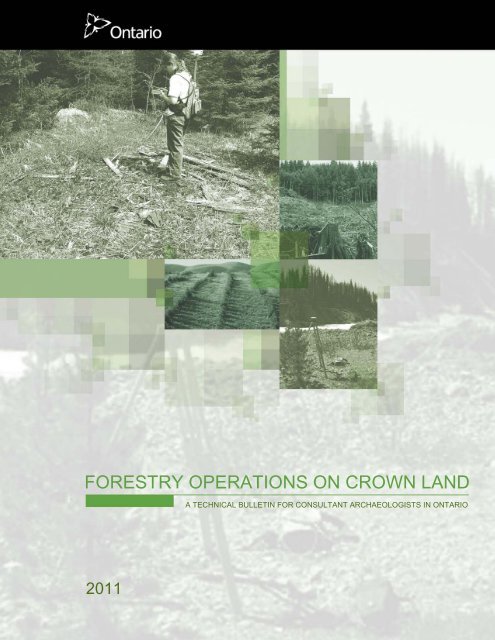
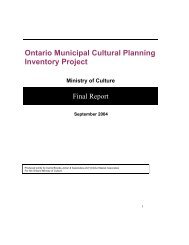
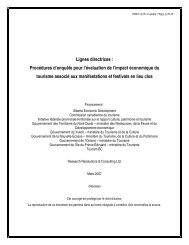
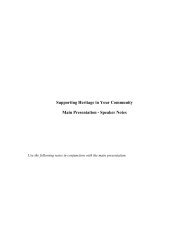
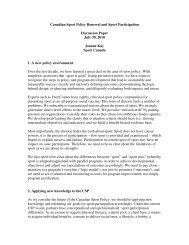
![THIS AGREEMENT made this [date], between [name of owner] (the ...](https://img.yumpu.com/49827605/1/158x260/this-agreement-made-this-date-between-name-of-owner-the-.jpg?quality=85)

